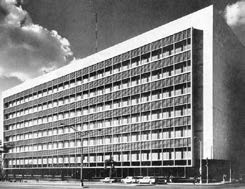Interior design in the 50’s. The lost paradise.
##plugins.themes.bootstrap3.article.main##
Abstract
Based in a set of architectural works, representative of Cuba?s modern movement, the contributions in terms of interior design, of several architects who integrated their design work into their entire creative work will be examined.
Our intention is to approach the expertise and authenticity of Cuban designers who, in the implementation of both specific solutions for housing problems and different social purposes? buildings, created, as a result of the way they structured the interiors, atmospheres where cultural identity translated into everlasting comfort and formal distinction.
We will focus in formal guidelines based in the use of domestic materials and the interpretation of the application opportunities offered by in the international technological development of the 1950?s, as well as the synchronization with Cuban and foreign plastic art avant-garde, which gave the application of modern movement?s basic principles to interior management, a national character. The scope of this essay consists of every element which contributes to zoning and completing spaces, whatever is public, housing, furniture or otherwise.
##plugins.themes.bootstrap3.article.details##

This work is licensed under a Creative Commons Attribution-NonCommercial-ShareAlike 4.0 International License.
- Attribution — You must give appropriate credit , provide a link to the license, and indicate if changes were made . You may do so in any reasonable manner, but not in any way that suggests the licensor endorses you or your use.
- NonCommercial — You may not use the material for commercial purposes .
- No additional restrictions — You may not apply legal terms or technological measures that legally restrict others from doing anything the license permits.
- ShareAlike — If you remix, transform, or build upon the material, you must distribute your contribution under the same license as the original. NOTE: This point applies to numbers 1 to 20 of the magazine with the previous CC-BY-NC-SA 4.0 license. Does not apply to the new CC BY-NC 4.0 license from Volume 11, Number. 21 (2024).
References
Bermúdez, J. R. (2005). Clara Porset. Diseño y cultura. La Habana. Editorial de Letras Cubanas.
En caribe. Enciclopedia de Historia y Cultura del Caribe. An- tonio Quintana Simonetti. http://www.encaribe. org/ es/article/ antonio-quintana-simonetti/ 1743.
Gardinetti M. (2014). Modelo de la Maison Dom-ino en los jardines de la Bienal de Venecia. Disponible en http:
// tecnne.com/ le-corbusier/ dom-ino-uno-a-uno
Bermúdez, J. R. (2005). Clara Porset. Diseño y cultura. La Habana. Editorial de Letras Cubanas.
Fernández, A./ Archivo personal.
Lápidus, L. (2005). La encrucijada del Tiempo. La Haba- na. Fundación Luis Lápidus.
Martell, A., Martínez P. L., y Matamoros M. “Cin- cuenta Años de Arquitectura Interior en Cuba”. La Ha- bana. Macromedia Facultad de Arquitectura. CUJAE
Segre, R. (1989) Arquitectura y Urbanismo de la Revolución Cubana. La Habana.Pueblo y Educación.
----------- (1985) La Vivienda en Cuba: República y Revo- lución. La Habana. MES. La Habana.
Segre, R., Cárdenas E. y Aruca L. (1983) Historia de la Arquitectura y del Urbanismo III: A. Latina y Cuba. La Haba- na. ENSPES, MES.
Rodríguez, E.L. (1997). “La década incógnita/ Los 50: modernidad, identidad y algo más”. La Habana. Re- vista Arquitectura Cuba. UNAICC No. 376.
(1998) “Ricardo Porro: obra construída”. La Habana. Revista Arquitectura Cuba. UNAICC No. 377. 6-30






















